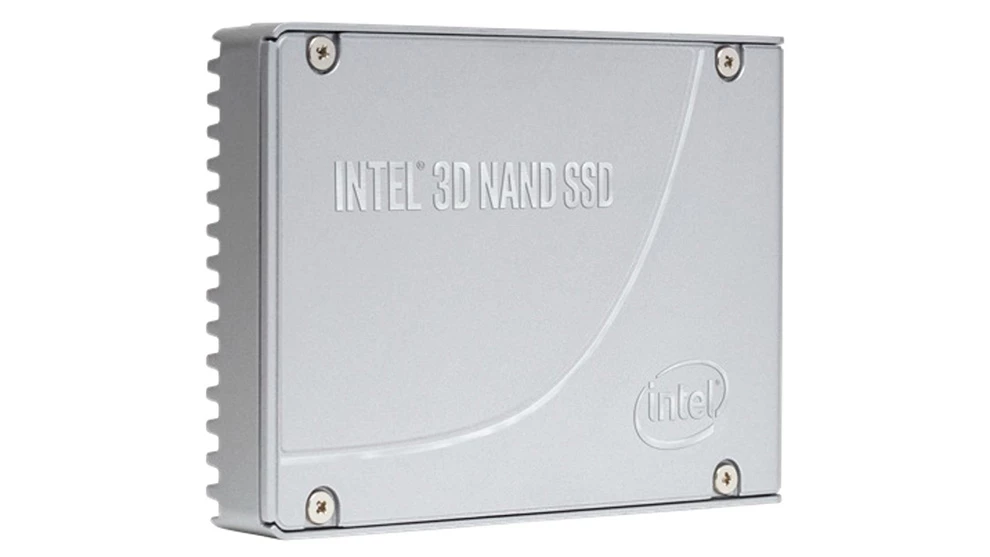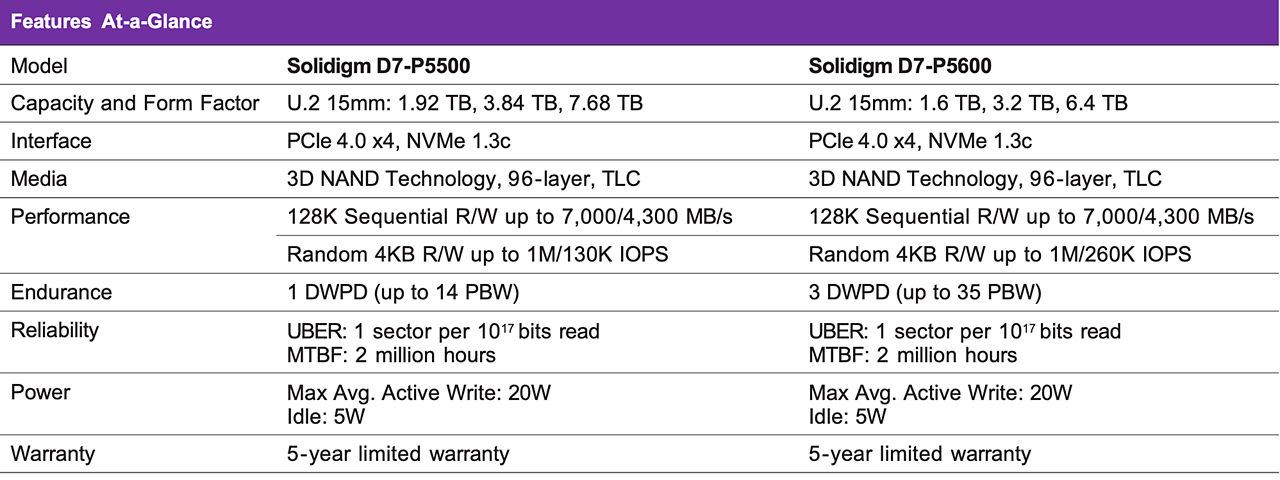Published November 5, 2023
Author Solidigm
Article
Solidigm™ D7-P5500 and D7-P5600 Product Brief
Formerly Intel® SSD D7-P5500 and Intel® SSD D7-P5600 Series
Architected with 96-layer TLC, 3D NAND technology, the Solidigm D7-P5500 and D7-P5600 offer optimized performance and capacity for all-TLC arrays and are designed to advance IT efficiency and data security. The D7-P5500 and D7-P5600 include an all new PCIe Gen4 controller and firmware that bring low latency, enhanced management capabilities, scalability and critical new NVMe features for Enterprise and Cloud environments.

Enterprise inspired, performance optimized Solidigm D7-P5500 and P5600. Download the Product Brief to explore how this TLC SSD can meet your enterprise, data center, and cloud storage needs.
Designed to meet today’s increasingly I/O-intensive requirements across a wide range of workloads while improving IT efficiency. Available in the U.2 15mm form factor, these SSDs offer 1.92 TB, 3.84 TB, and 7.68 TB at 1 Drive Write per Day (DWPD) and 1.6 TB, 3.2 TB, and 6.4 TB at 3 DWPD.
Unlock the value of stored data
The Solidigm D7-P5500 and D7-P5600 deliver predictably fast, high performance and can greatly accelerate all-TLC storage arrays. Compared to previous-gen SSDs, the capacity-optimized D7-P5500 delivers up to 2x sequential performance [1] and the performance-optimized D7-P5600 brings up to 44% higher random mixed-workload performance. [2] Both drives also offer improvements to tail latencies, including up to 80% lower 4KB Random Read Quality of Service (QoS) for 99.99999% (7 9s) of transactions. [3] Firmware enhancements such as prioritizing host workloads and enabling updates without reset further elevate application performance.
Advanced features for drive performance, IT efficiency, and data security
The D7-P5500 and D7-P5600 include numerous firmware enhancements specifically designed to improve IT efficiency and data security in an increasingly data-centric world.
- Dynamic namespace management delivers the flexibility to enable more users and scale deployment.
- Additional security features like TCG Opal 2.0 and a built-in AES-XTS 256-bit encryption engine, which are required by some secure platforms.
- Enhanced SMART monitoring, which reports drive health status without disrupting I/O data flow using an in-band mechanism and out-of-band access.
- Telemetry 2.0 makes a wide range of stored data accessible and includes intelligent error tracking and logging. This increases the reliability of finding and mitigating issues and supports accelerated qualification cycles — all of which can result in increased IT efficiency.
- Optimized TRIM architecture now runs as a background process without interference to workloads, improving performance and QoS during concurrent TRIMs. The TRIM process is improved for high-density drives, with reduced write amplification that helps drives meet their endurance goal.
- A Power-Loss imminent (PLI) protection scheme with built-in self-testing, guards against data loss if system power is suddenly lost. Coupled with end-to-end data path protection scheme, PLI features also enable ease of deployment into resilient data centers where data corruption from system-level glitches is not tolerated.
Extending NAND technology leadership
Solidigm’s 96-layer 3D NAND technology delivers industry-leading areal density and data retention, [4] enabling enterprise customers to confidently scale storage arrays to meet their growing needs. The swift adoption of software-defined and hyperconverged infrastructures increases the requirement to maximize efficiency, revitalize existing hardware, and increase server agility—all while maintaining operational reliability.
Meeting the demand of increasingly I/O-intensive workloads, including AI and Analytics, has become a core element for any enterprise strategy. Top enterprise server manufacturers have responded by embracing PCIe/NVMe-based SSDs with scalable performance, low latency, and continuous innovation.

Notes
[1] Comparing D7-P5600 and DC-P4610 performance. See DC-P4610 Product Brief.
[2] Source – Solidigm. Comparing measured performance for 4KB (4096 Bytes) 70/30 Random Read/Write QD256 (32x8w) performance between the SSD D7-P5600 6.4TB and DC-P4610 6.4TB. Test and System Configuration: CPU: Intel® Xeon® Gold 6139 @ 2.30GHz, BIOS: SE5C620.86B.00.01.0014.070920180847, RAM: 96GB, RAM Model: DDR4 2666MHz, Chipset: Intel® C624 Chipset, Hyper-Threading: Disabled, CPU Governor (through OS): Performance Mode, OS: CentOS 7.2, Kernel: 4.8.6. Measured performance was 520K IOPS and 360K IOPS for the D7-P5600 and DC P4610, respectively. Measurements are performed on a full Logical Block Address (LBA) span of the drive once the workload has reached steady state but including all back- ground activities required for normal operation and data reliability. Power mode set at PM0.
[3] Tail latencies refer to response times in a worst-case scenario; lower latencies at 99.99% (4 9s) mean that the slowest transaction out of every 10,000 transactions will improve. Source – Solidigm. Comparing measured performance for 4KB 100% Random Read QD1 latencies at 99.99999% (7 9s) availability between the D7-P5600 6.4TB and DC-P4610 6.4TB. D7-P5600 and DC-P4610 were measured on each drive’s latest production firmware, “10019” and “1047E”, respectively. Measured latency was 0.48ms and 2.57ms for the D7-P5600 and DC-P4610, respectively. Performance for both drives measured using FIO Linux CentOS 7.2 kernel 4.8.6 with 4KB (4096 bytes) of transfer size with Queue Depth 1 (1 worker). Measurements are performed on a full Logical Block Address (LBA) span of the drive once the workload has reached steady state but including all back- ground activities required for normal operation and data reliability. Power mode set at PM0.
[4] Source: IEEE International Solid State Circuits. ISSCC 2015, J. Im; ISSCC 2017 R Yamashita; ISSCC 2017 C Kim; ISSCC 2018; H. Maejima; ISSCC 2019 C. Siau.Measurements were performed on components from SSDs using floating gate and charge trap flash technology. Measurement platform used was Teradyne Magnum 2 Memory test systems, and programming using random patterns and margins were quantified using customer commands. Data measured in 08/2019.
Software and workloads used in performance tests may have been optimized for performance only on Intel microprocessors. Performance tests, such as SYSmark and MobileMark, are measured using specific computer systems, components, software, operations and functions. Any change to any of those factors may cause the results to vary. You should consult other information and performance tests to assist you in fully evaluating your contemplated purchases, including the performance of that product when combined with other products. For more complete information visit https://www.solidigm.com/.
Performance results are based on testing as of the date shown in configurations and may not reflect all publicly available updates. See backup for configuration details. No product or component can be absolutely secure.
Your costs and results may vary.
Solidigm technologies may require enabled hardware, software, or service activation.
© Solidigm. Solidigm and the Solidigm logo are trademarks of Solidigm in the U.S. and/or other countries. Other names and brands may be claimed as the property of others.